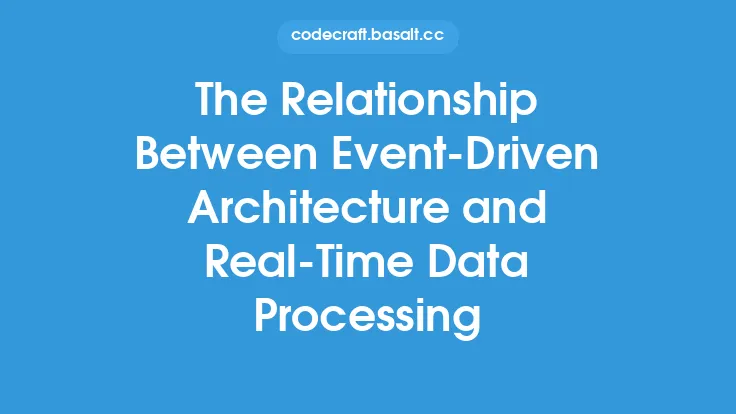Event-driven architecture (EDA) has become a popular approach to building scalable and flexible software systems. At the heart of EDA lies event sourcing, a technique that involves storing the history of an application's state as a sequence of events. In this article, we will delve into the importance of event sourcing in event-driven architecture, exploring its benefits, challenges, and best practices.
Introduction to Event Sourcing
Event sourcing is an architectural pattern that involves storing the history of an application's state as a sequence of events. Each event represents a significant change to the application's state, such as the creation of a new user or the placement of an order. By storing these events, an application can reconstruct its current state by replaying the sequence of events that led to it. This approach provides a number of benefits, including improved scalability, flexibility, and fault tolerance.
Benefits of Event Sourcing
One of the primary benefits of event sourcing is that it allows for the creation of highly scalable systems. By storing events in a log, an application can handle high volumes of traffic without becoming overwhelmed. This is because the log can be easily replicated and distributed across multiple nodes, allowing the application to scale horizontally. Additionally, event sourcing enables the creation of flexible systems that can adapt to changing business requirements. By storing the history of an application's state, developers can easily modify the application's behavior by adding new events or modifying existing ones.
Challenges of Event Sourcing
While event sourcing provides a number of benefits, it also presents several challenges. One of the primary challenges is the complexity of implementing an event-sourced system. This requires a deep understanding of the underlying architecture and the ability to design and implement a robust event store. Additionally, event sourcing can lead to increased storage requirements, as the log of events can grow rapidly over time. This can be mitigated through the use of techniques such as event compression and log rotation.
Event Store Design
The event store is a critical component of an event-sourced system, responsible for storing and retrieving events. When designing an event store, there are several factors to consider, including performance, scalability, and data consistency. One approach is to use a relational database, such as MySQL or PostgreSQL, to store events. However, this can lead to performance issues and scalability limitations. A better approach is to use a NoSQL database, such as Apache Cassandra or MongoDB, which is optimized for high-performance and scalability.
Event Versioning and Serialization
Event versioning and serialization are critical aspects of event sourcing. As the application evolves, new events may be added, and existing events may be modified. To ensure backwards compatibility, it is essential to implement a robust event versioning strategy. This can be achieved through the use of techniques such as event version numbers or semantic versioning. Additionally, events must be serialized and deserialized correctly to ensure that they can be stored and retrieved correctly. This can be achieved through the use of formats such as JSON or Avro.
Rebuilding State from Events
One of the key benefits of event sourcing is the ability to rebuild an application's state from the log of events. This can be achieved through the use of a technique called event replay. When an application starts, it can replay the log of events to rebuild its current state. This provides a number of benefits, including improved fault tolerance and the ability to debug complex issues. However, it also presents several challenges, including the need to handle duplicate events and ensure that the application's state is consistent.
Conclusion
In conclusion, event sourcing is a critical component of event-driven architecture, providing a number of benefits, including improved scalability, flexibility, and fault tolerance. While it presents several challenges, including complexity and increased storage requirements, these can be mitigated through the use of techniques such as event compression and log rotation. By understanding the importance of event sourcing and implementing it correctly, developers can create highly scalable and flexible software systems that meet the needs of modern businesses.





